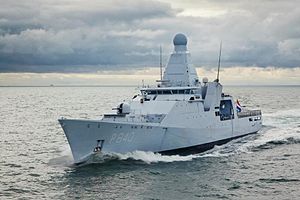Holland-class offshore patrol vessels

HNLMS Holland (Min. of Defence)
|
|
| Class overview | |
|---|---|
| Builders: |
|
| Operators: |
|
| Cost: |
|
| In commission: | 2012–present |
| Completed: | 4 |
| Active: | 4 |
| General characteristics | |
| Type: | Offshore patrol vessel |
| Displacement: | approx. 3,750 tons full load |
| Length: | 108.4 m (355 ft 8 in) |
| Beam: | 16 m (52 ft 6 in) |
| Draught: | 4.55 m (14 ft 11 in) |
| Propulsion: |
|
| Speed: | 21.5 knots (39.8 km/h; 24.7 mph) |
| Range: | 5,000 nautical miles (9,300 km; 5,800 mi) at 15 knots (28 km/h; 17 mph) |
| Endurance: | 21 days |
| Boats & landing craft carried: |
|
| Complement: | 54 (+ additional space for 40) |
| Sensors and processing systems: |
|
| Armament: |
|
| Aircraft carried: | 1 x NH90 helicopter |
| Aviation facilities: | fully equipped hangar and flight deck for one medium-sized helicopter |
The Holland-class offshore patrol vessels are a class of 4 offshore patrol vessels constructed for the Royal Netherlands Navy. They are designed to fulfill patrol and intervention tasks against lightly armed opponents, such as pirates and smugglers, but have much higher level electronic and radar surveillance capabilities which are used for military stabilization and security roles, short of outright war. Without sonar or long range weapons, they utilize the surveillance capabilities of the Thales integrated mast, which integrates communication systems and two 4-faced phased arrays for air and surface search.
A contract between the Royal Netherlands Navy and Damen Schelde Naval Shipbuilding in Vlissingen, the Netherlands was signed in 2007 for the construction of four vessels at a total cost of €467.8 million.
The vessels resulted from the Dutch Ministry of Defence's Marinestudie. The study proposes the sale of four existing Karel Doorman-class frigates, and using the proceeds and savings of the sale to commission four dedicated patrol vessels, allow the building of a more capable Joint Support Ship to replace the auxiliary replenishment ship HNLMS Zuiderkruis, and reintroducing a mine-sweeping capability to the Dutch Navy.
The vessels are designed for global use, in particular to be deployed to the Caribbean region, the South China Sea and the North Sea. They have the capability to carry out missions such as anti-piracy and blockade duties, and also can be used for emergency transport. They are constructed with heavier mild steel and armour, which results in a more robust ship of greater weight, than the previous M class frigates
The Holland class' main armament is a 76 mm Oto Melara Super Rapid gun with a firing rate of 120 rounds per minute and an maximum range of 16 km (9.9 mi).
Secondary armament is provided by a 30 mm Oto Melara Marlin WS rapid cannon, two 12.7 mm Oto Melara Hitrole NT's and two 12.7 mm M2HB machine guns. All can be remotely operated.
The ships are able to monitor to 250 km (160 mi) range air, missile and UAV targets and 70 km (43 mi) range surface targets using a Thales Integrated Sensor and Communication Systems (ISCS), comprising a SeaMaster 400 air warning radar, a Watcher 100 active phased-array surface detection and tracking radar, claimed to be able to detect small objects such as mines and periscopes on the sea surface at 40 km (25 mi) range, link 11 & 16 data links a mine detection sonar and an infra-red Gatekeeper/electro-optical (EO) warning system. The sensor systems are housed in an integrated mast, also provided by Thales, called the I-Mast 400. Thales also built the satellite communications system for the ships.
...
Wikipedia
